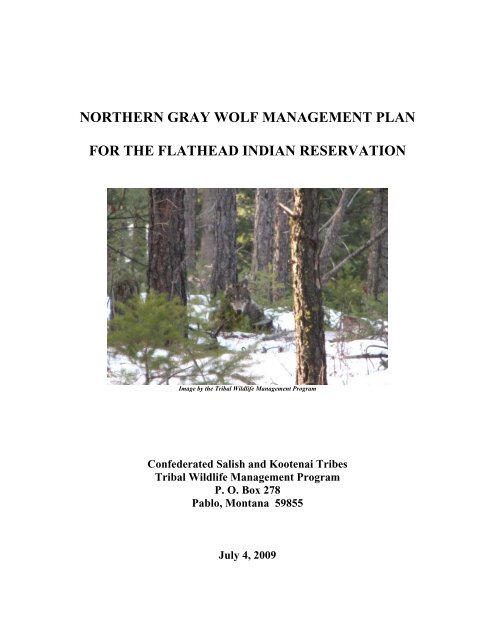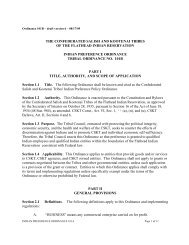CSKT Wolf Management Plan - Confederated Salish and Kootenai ...
CSKT Wolf Management Plan - Confederated Salish and Kootenai ...
CSKT Wolf Management Plan - Confederated Salish and Kootenai ...
You also want an ePaper? Increase the reach of your titles
YUMPU automatically turns print PDFs into web optimized ePapers that Google loves.
IntroductionThe <strong>Salish</strong>, <strong>Kootenai</strong> & Pend d’Oreille people have always stressed theimportance of a “balanced ecosystem”, <strong>and</strong> according to the <strong>Salish</strong> & Pend d’OreilleTribal Elders, the wolf is considered to be a vital part of the ecosystem. They believe thatthe wolf takes sickness away from the herd, therefore helping the herd to maintain anoverall herd health. (<strong>Salish</strong> & Pend d’Oreille Culture Committee, unpubl. data). Otherpeople have expressed admiration for the wolf’s skill as a hunter.The recovery of the Gray <strong>Wolf</strong> (Canis lupus) to the Northern Rocky MountainRegion (NRM), which includes Montana, Idaho <strong>and</strong> Wyoming, has been amazing, to saythe least. Needing little help, the natural emigration of wolves from Canada into Idaho<strong>and</strong> Montana was first documented in the 1970s (Pletscher et al. 1997). Reintroductionefforts of 1995 at Yellowstone National Park (YNP) <strong>and</strong> northeastern Idaho allowed thistop predator to strengthen its foothold in the NRM (Bangs et al. 1998). At the end of2008, there was an estimated minimum of 1,695 wolves with 95 breeding pairs inMontana, Idaho <strong>and</strong> Wyoming, with 497 wolves, consisting of 39 breeding pairs inMontana alone (Sime et al. 2009)The welcome mat has not always been out for wolves in Montana <strong>and</strong> otherRocky Mountain states. <strong>Wolf</strong> packs were thought to have been eliminated from Montanaby the 1930’s, primarily due to the statewide bounty offered for each wolf hide. By the1970’s, only a few rare sightings were reported, with an occasional wolf kill still beingreported. This eventually led to the 1974 listing of the northern gray wolf as“endangered” under the federal Endangered Species Act (ESA) <strong>and</strong> ongoing management<strong>and</strong> recovery efforts directed by the U. S. Fish <strong>and</strong> Wildlife Service (USFWS).In 1980, efforts began with the Rocky Mountain <strong>Wolf</strong> Recovery Team to fullyrecover the species <strong>and</strong> eventually remove it from the Endangered Species List.Recovery goals were developed with a minimum of 30 breeding pairs established (U. S.Fish <strong>and</strong> Wildlife Service 1987). These recovery goals were first achieved in 2002 (Simeet al. 2007).The rate of recovery of gray wolves exceeded many people’s expectations, butthere was little doubt that at some point wolves would no longer need the continuedprotections of the ESA. With that realization, wildlife management agencies have beenassembling appropriate management plans to guide the future of the species. Theseefforts originally involved monitoring <strong>and</strong> conflict resolution, but with the increase inwolf populations <strong>and</strong> the attendant conflicts between wolves <strong>and</strong> stockgrowers, seriousconcerns about the impacts of wolves upon big game populations have also been majorissues.The three states within the NRM, along with tribal governments, have completedor are currently working on conservation plans to take over the management of wolvesfrom the USFWS, after delisting from the ESA occurs. The efforts of those entities are invarious stages of completion. Montana <strong>and</strong> Idaho have completed wolf management3
plans which have received the approval of the USFWS, as has a plan for the Wind RiverIndian Reservation. The Service has assisted in the review <strong>and</strong> development of wolfmanagement plans for the Blackfeet Indian Reservation <strong>and</strong> the Nez Perce Reservation.The USFWS continues to have disagreements over Wyoming’s plan, which is notapproved.Delisting (removal of gray wolves from the Endangered Species List), officiallyfirst occurred in March 27, 2008. That decision was subsequently overturned due toquestions raised in litigation, <strong>and</strong> the gray wolf listing was reinstated in July 18, 2008.Subsequent responses to the litigation by the USFWS resulted in a second de-listingeffort which was published on April 2, 2008, with the official de-listing occurring onMay 4, 2009. Final implementation of that action is also being litigated, by severalconservation organizations <strong>and</strong> the state of Wyoming.Once gray wolves are de-listed, management will rest in the h<strong>and</strong>s of statewildlife management agencies <strong>and</strong> all tribal wildlife management programs within thosestates. The continued existence of the gray wolf in the NRM <strong>and</strong> other areas withoutbeing re-listed as a Threatened or Endangered Species will require careful management<strong>and</strong> close coordination of management activities between all agencies involved. As aresult, state <strong>and</strong> tribal wildlife managers will coordinate their wolf management activitiesto enhance both the effectiveness <strong>and</strong> efficiency of available funding mechanisms.Ecology of the Northern Gray <strong>Wolf</strong>The gray wolf is the largest native canid species. Adults range from 60-130pounds <strong>and</strong> measure four <strong>and</strong> a half feet to six feet in length <strong>and</strong> twenty-six to thirty-eightinches tall. The gray wolf can vary in color from white, gray, to pure black.Characteristics such as; longer legs, large feet, straight tail, <strong>and</strong> broad head <strong>and</strong> snout,help distinguish it from other closely related canid species. Tracks are another way tocorrectly identify a wolf from other canids, their front tracks generally measure 3 7/8” to5 ½” long by 2 3/8” to 5” wide, with the rear track measuring 3 1/8” to 4 ¾” long by 2 ¼”to 4 ¼” wide (Rezendes 1999).Another major feature that sets the gray wolf apart from other canids is theirstrong social connection to one another. Wolves tend to form packs, which can varygreatly in size. In 2008, Montana Fish, Wildlife & Parks (MFWP) found that Montana’swolf pack averaged 6.0 individuals per pack (Sime et al. 2009). Pack members generallyconsist of a breeding dominant pair, their young of the year <strong>and</strong> the previous year’soffspring. However, unrelated wolves are occasionally allowed to join the pack.Cooperation by all members of the pack is critical for survival. The pack travelstogether, <strong>and</strong> pack members help to rear young, defend territory against intruders <strong>and</strong>hunt <strong>and</strong> eat as a family group.Breeding primarily occurs between the alpha male <strong>and</strong> alpha female, <strong>and</strong> has beenfound to be at its peak in mid- to late-February in the Rocky Mountain Region (Boyd et4
al. 1993). However, breeding by more than one female in a pack has been documented inwolf packs in Yellowstone National Park (YNP) (Smith et al. 2000) <strong>and</strong> on the FlatheadIndian Reservation (FIR) in 2008, resulting in more than one litter of pups (Sime et al2009). In 2008, twenty-seven wolves were documented in the Hog Heaven pack on theFlathead Indian Reservation, including 2 breeding females <strong>and</strong> 15 pups. This is thelargest recorded pack in Montana [a pack of 37 wolves was documented in YellowstoneNational Park], <strong>and</strong> it is only the third time that a double litter has been documented inMontana in 23 years. On average, one litter of 5 pups is born in late April.When juveniles reach sexual maturity, which generally occurs around 22 months(Mech 1970), some choose to disperse from the pack. These individuals are known as“dispersers”, <strong>and</strong> tend to leave the pack at 1 to 3 years of age (Boyd et al. 1993, Sime2008). In Northwestern Montana, dispersers were found to leave mainly during courtship(January-February), or breeding season (May-June) (Boyd <strong>and</strong> Pletscher 1999).Disease, like distemper <strong>and</strong> parvovirus, <strong>and</strong> lack of nutrition are major factorsaffecting pup survival (Mech <strong>and</strong> Goyal 1993, Johnson et al. 1994). Adult survival in theRocky Mountain Region is affected mainly by human-caused deaths, due to conflictswith livestock, as well as being killed by other wolves defending their territory (Mech etal. 2003). Other human-caused deaths can be associated to vehicle <strong>and</strong> train collisions.An analysis of wolf radio telemetry data in the NRM from 1984-2004 indicated onaverage 26% of the adult-sized wolves die each year. Overall, morality occurs fromagency control (10%/yr.), illegal killing (10%/yr.), human-caused accidents (3%/yr.) <strong>and</strong>natural causes (3%/yr.).<strong>Wolf</strong> habitat is difficult to classify, due to the fact that it’s totally dependant onprey availability, therefore variations in territory boundaries from year to year are notuncommon. In 1999, the average territory of a wolf pack within Northwest Montana was185 square miles (USFWS et al. 2000). Territories in the NRM range can be as large as500 square miles.The gray wolf is considered to be an opportunistic feeder <strong>and</strong> known to scavengewinter kill or livestock carcasses. Their primary natural prey species consists of whitetaileddeer (Odocoileus virginianus), mule deer (Odocoileus hemionus), elk (Cervuselaphus), moose (Alces alces) <strong>and</strong> beaver (Castor canadensis); however, beingopportunistic predators, they will <strong>and</strong> are capable of taking a wide variety of prey species.Their affect on ungulate populations <strong>and</strong> how well ungulates will adjust are notcompletely understood but varies on a host of factors. In 1999, white-tailed deer made up83% of a wolves diet in northwestern Montana, with elk <strong>and</strong> moose comprising of 14%<strong>and</strong> 3%, respectively (Kunkel et al 1999). Recent research on wolf-ungulate interactionsin southwestern Montana indicated elk as preferred prey for wolves, with varying degreesof predation impacts observed on the elk populations studied (Hamlin et al. 2008).Studies with YNP have found that, with the reintroduction of this top predator, thenatural ecosystem as a whole has been recovering. For example, elk populations arebeing forced to use different habitats; therefore the aspen (Populus tremuloides) <strong>and</strong>5
willow (Salix spp.) that they have heavily over-utilized are recovering (Jones 1974,DeByle 1985, Boyce 1989). This in turn benefits migratory birds that use thesedeciduous trees at various times of the year for nesting <strong>and</strong> foraging. Other wildlifespecies that are scavengers (coyotes (Canus latrans, birds, etc.) are also benefiting fromleftover kills made by wolves year-round, rather than depending on winterkill only duringthe early spring months (Kunkel et al. 1999).The return of wolves to the l<strong>and</strong>scape of the NRM retains a wide range of visceralfeelings for the human residents of the region. The presence of wolves on the l<strong>and</strong>scapeis viewed by many Native Americans as the return of a brother <strong>and</strong> by environmentalistsas the return of a missing piece of the ecological puzzle. Other viewpoints contrastsharply. Wolves preying upon livestock have caused considerable <strong>and</strong> serious concernabout its presence by stock growers. In addition, many big game hunters have concernsabout both the short <strong>and</strong> long-term impacts of a recovered <strong>and</strong> productive wolfpopulation upon big game populations that they hunt <strong>and</strong> subsist on.Clearly the return of the wolf <strong>and</strong> how it will be managed has created the greatestcontroversy in wildlife management since the extreme reductions of wildlife populationsthroughout North America during the time of settlement. As a result, wildlife managersfind themselves attempting to reconcile the diverse opinions of factions that refuse tocompromise their beliefs <strong>and</strong> principles about gray wolves in an effort to forge a longtermmanagement strategy that provides for the best consideration of all viewpoints.Current Status of Gray Wolves in the Northern Rocky MountainsWithin the exterior boundaries of the states of Montana, Idaho <strong>and</strong> Wyoming(including Indian Reservations), field reconnaissance has indicated a minimum ofapproximately 1,645 wolves in 95 breeding pairs of wolves at the end of 2008. WithinMontana at that time, a minimum of approximately 422 wolves in 73 packs, 39 of whichwere classified as breeding pairs that had at least two pups survive until the end of theyear. As of December 31, 2008, Montana Fish, Wildlife <strong>and</strong> Parks reported that theminimum wolf population in Montana was 497 wolves in 84 verified packs, with 34breeding pairs represented. That data indicated an 18% increase during the previous year<strong>and</strong> a 34% increase over the previous two years. In northwestern Montana, a minimumof 282 wolves in 45 packs, including 18 breeding pairs were reported (Sime et al. 2009).Current Status of Gray Wolves on the Flathead Indian ReservationRecords of wolf observation on the Flathead Indian Reservation prior to the 1990sseem to be sporadic <strong>and</strong> usually undocumented. Most reports involved observations ofsuspected wolves in the northwestern corner of the Reservation. In 1992, the movements<strong>and</strong> colonization of wolves in the Ninemile Valley, just south of the Reservation, were atopic of interest to many. In 1993, the first documented activity in the south end of the6
Reservation was reported, <strong>and</strong> shortly thereafter, depredation by wolves upon cattle wasreported <strong>and</strong> verified.Since that time, there have been several reported observations of wolves, someverified <strong>and</strong> some not verified. Activity has been heavily concentrated primarily in thewestern half of the Reservation <strong>and</strong> along the southern boundary areas. The Hog Heavenarea has likely seen the most activity <strong>and</strong> has been the site of at least three differentpacks. Other activity has been regular along the western <strong>and</strong> southern boundaries of theReservation, in addition to activity in the <strong>Salish</strong> Mountains.As of April 2009, Tribal Wildlife Biologists have observed active wolf packs infour locations on the Reservation. These packs include a minimum of 15 wolves. Inaddition, observations of wolf activity have been documented at three other locations.The number of animals at those locations is yet to be determined.Given the ability of wolves to range over large l<strong>and</strong>scapes with relative ease, theReservation can play host to wolves that not only den <strong>and</strong> spend most of their time on theReservation, but the area may also be utilized by wolves from adjacent areas. As a result,wolves from other packs in these areas, as well as other non-territorial wolves fromelsewhere may occasionally move back <strong>and</strong> forth across the boundaries of theReservation. As of late 2008, 49 wolves from 5-6 additional adjacent areas (Sime et al.2009), such as the Thompson River Drainage, the Ninemile area <strong>and</strong> the Swan Valleymay also have moved on <strong>and</strong> off of the Reservation.Definition of NeedAs in other areas of the Northern Rockies, the Flathead Indian Reservation hasbeen the location of several conflicts with livestock <strong>and</strong> other domestic animals. In eachcase, Tribal Wildlife <strong>Management</strong> Program staff, Tribal Fish <strong>and</strong> Wildlife ConservationOfficers <strong>and</strong> U. S. Department of Agriculture Wildlife Services staff have jointlyinvestigated the conflict sites <strong>and</strong> taken action to alleviate the conflicts. These actionshave included the use of non-lethal techniques, such as hazing, installation of fladry <strong>and</strong>the use of noise making devices.When non-lethal techniques fail to deter wolves from taking livestock,authorization has been sought from the Tribal Council <strong>and</strong> the U. S. Fish <strong>and</strong> WildlifeService to kill one or two wolves at the conflict site to attempt to preclude furtherdepredations. When that has failed, authorizations have been requested to kill the entirepack involved. At the same time, active management has been balanced with publicinformation <strong>and</strong> information for stockgrowers involved to provide examples of how topotentially avoid future depredation conflicts.7
<strong>Management</strong> GoalThe goal of this wolf management plan is to provide for the long-term presence ofwolves on the Flathead Indian Reservation while simultaneously minimizing conflictsbetween wolves <strong>and</strong> humans. In attempting to do so, the cultural significance of wolvesmust be acknowledged, <strong>and</strong> animals must be respected <strong>and</strong> treated in a humane manner,even during control actions.The management of wolves on the Reservation will be coordinated with wolfmanagement activities of other state <strong>and</strong> federal agencies in such a way as to support theviability of wolves as a native species in northwestern Montana <strong>and</strong> prevent the need forre-listing of the species under the federal Endangered Species Act. The followingobjectives are the foundation for wolf management on the Flathead Indian Reservation.Each are important issues that will be considered in conducting wolf managementactivities.Objectives1) Acknowledge the cultural beliefs <strong>and</strong> concerns of the <strong>Salish</strong>, <strong>Kootenai</strong> <strong>and</strong> Pendd’ Oreille people with regard to wolves <strong>and</strong> incorporate reverence for those to theextent possible in wolf management.2) Consider the ecology <strong>and</strong> behavioral aspects of wolves in developingmanagement prescriptions for wolves.3) Inform residents of the Flathead Indian Reservation about wolf ecology <strong>and</strong>management to the extent possible.4) Work cooperatively with state <strong>and</strong> federal agencies to monitor local, regional <strong>and</strong>range-wide wolf populations <strong>and</strong> manage conflicts efficiently to the extentpossible.5) Assess the influence of wolves upon big game <strong>and</strong> act as appropriate.6) Work cooperatively with livestock growers to assess depredation complaints <strong>and</strong>to assist in developing solutions to those conflicts, including providing assistancewith damage compensation claims to available sources.7) Consider human safety as a potential management concern related to the presenceof wolves.Tribal <strong>Wolf</strong> <strong>Management</strong> PolicyOn April 16, 2009, the Tribal Council approved a policy indicating support fortreatment of gray wolves as a native wildlife species which requires active management.In doing so, the Council realized the cultural <strong>and</strong> ecological significance of wolves tomany of its constituents. The Council also acknowledged the potential for conflictsbetween wolves <strong>and</strong> local populations of big game <strong>and</strong> other wildlife, as well as thepotential for conflicts between wolves <strong>and</strong> domestic livestock. The Council decision8
favored a balanced approach to wolf management that attempts to take all of these factorsin to account.This wolf management policy will neither manage toward a maximum nor aminimum number of wolves on the Flathead Indian Reservation. <strong>Management</strong> directionwill attempt to assure the long term presence of a wolf population, minimize the potentialof conflict with humans <strong>and</strong> resolve that conflict when it occurs. <strong>Wolf</strong> populationmanagement will depend heavily upon wolf behavior <strong>and</strong> amount of conflict with otherwildlife, livestock <strong>and</strong> people. For example, if there are few or no conflicts with a higherpopulation of wolves on the Reservation, no excessive effort to reduce the wolfpopulation will occur. However, if limited numbers of wolves occur on the Reservation<strong>and</strong> if those wolves repeatedly kill livestock, or if excessive numbers of big game or otherwildlife species are documented as killed by wolves, lethal control may be implemented.ImplementationRegulations <strong>and</strong> StatutesThe gray wolf is recognized as a native wildlife species by the <strong>Confederated</strong><strong>Salish</strong> <strong>and</strong> <strong>Kootenai</strong> Tribes. Under the provisions of this management plan, gray wolvesare not subject to taking by hunting or trapping at this time, although the Tribal Councilmay consider such taking at a later date.The only legal taking would occur for administrative reasons, such as taking ofaggressive wolves that threaten human safety or problem wolves that kill domesticanimals <strong>and</strong> livestock. Livestock growers may also take problem wolves that areattempting to kill or are observed feeding on livestock that the wolves have recentlykilled under specific guidelines.While wolves have not been documented as a significant human safety concern,the potential does exist that they might threaten humans under certain circumstances. Asa result, wolves that are openly aggressive toward humans can be harassed or killed underspecific guidelines. Those guidelines can be found in Table 1.Regulations regarding wolves will be included in the annual Fish, Wildlife <strong>and</strong>Recreation Regulations developed by the Tribal Division of Fish, Wildlife Recreation <strong>and</strong>Conservation. These regulations will be reviewed annually by the Tribal Council <strong>and</strong> thepublic, <strong>and</strong> the Council may approve changes as necessary. These regulations will beenforced by the Tribal Fish <strong>and</strong> Game Conservation Program, <strong>and</strong> the staff of thisprogram will coordinate with federal, state <strong>and</strong> local authorities as necessary to enforcethe regulations.9
Departmental ResponsibilitiesThe Tribal Wildlife <strong>Management</strong> Program will be responsible for implementationof the Tribal Gray <strong>Wolf</strong> <strong>Management</strong> <strong>Plan</strong>. The Tribal Wildlife Program Manager willhave discretion to make decisions on day-to-day management of individual wolves,including coordination of interagency monitoring <strong>and</strong> management activities <strong>and</strong> biggame <strong>and</strong> livestock depredation management. Tribal Wildlife <strong>Management</strong> Programstaff will work closely with the Tribal Fish <strong>and</strong> Game Conservation Program inconducting wolf management activities. Tribal Wildlife <strong>Management</strong> Program staff willalso work cooperatively with United States Department of Agriculture Wildlife Servicespersonnel to respond to livestock depredation complaints. The Tribal Wildlife<strong>Management</strong> Program will also coordinate with Montana Fish, Wildlife <strong>and</strong> Parks asappropriate on wolf management issues that affect wolves that routinely use both state<strong>and</strong> tribal l<strong>and</strong>s.Public Information <strong>and</strong> OutreachA wide variety of methods will be utilized to keep the public informed of wolfactivity <strong>and</strong> management activities. Print <strong>and</strong> broadcast media will carry information onwolf management topics. The opportunity also exists for the development of a TribalWildlife <strong>Management</strong> Program website that could be used as a reference for ongoingmanagement activities, as well as for educational opportunities.Conflict <strong>Management</strong>Investigation of ConflictsConflicts between wolves <strong>and</strong> livestock will likely occur occasionally. When thathappens, all calls, complaints <strong>and</strong> reports of conflicts will be investigated as quickly aspossible to determine the nature of the conflict <strong>and</strong> to ascertain if wolves are involved.If livestock or domestic animal depredation occurs, animals killed should becovered with a tarp or other cover to preserve the scene for investigation. Foot traffic <strong>and</strong>other activity in the vicinity which might obscure evidence of depredation should also belimited.Any investigations of possible wolf depredation of livestock or domestic animalswill include examination of dead <strong>and</strong> injured livestock as necessary to attempt to bestdetermine cause of injury of death. All investigations will use caution not to damage ordestroy evidence. Images pertinent to the incident will be included, along with anarrative of the incident. All results will be documented in a case file. The information inthe case file will be used to assess the situation <strong>and</strong> to determine an appropriate course ofmanagement action.10
In general, non-lethal methods of wolf control will be utilized initially. Ifrepeated depredations occur or the non-lethal methods of control are ineffective, the useof lethal control of depredating wolves will be considered. <strong>Management</strong> responses towolf/human conflicts are listed in Table 1.Assistance of USDA Wildlife Services Agents will be requested as deemednecessary by Tribal Wildlife <strong>Management</strong> Program personnel. The Tribes maintain aMemor<strong>and</strong>um of Agreement with that agency for cooperative management of livestockdepredation issues.Table 1. <strong>Management</strong> Responses to <strong>Wolf</strong>/Human ConflictsConflict TypeMild habituation to humans or firstincidence of food conditioningMajor habituation or subsequent evidenceof food conditioningLivestock depredation-first incident.Livestock depredation-subsequentincidents.Responses1 wolf or multiple wolves:Nonlethal harassment, trapping, collaring,<strong>and</strong> monitoring. Examine reason forconflict <strong>and</strong> apply preventative measures.1 wolf:Lethal controlMultiple wolves:Trapping, collaring, <strong>and</strong> monitoringcombined with harassment <strong>and</strong> lethalcontrol of 1 or more of the wolves.Examine reason for conflict <strong>and</strong> applypreventative measures.1 wolf:Lethal control or trapping, collaring, &monitoringMultiple wolves:Trapping, collaring, monitoring. Examinelivestock practices <strong>and</strong> use changes orpreventative measures if needed.1 wolf:Lethal controlMultiple wolves:Trapping, collaring, monitoring combinedwith lethal control of 2-3 wolves. Examinelivestock practices <strong>and</strong> use changes orpreventative measures if needed. Evaluateeffectiveness of actions. More wolveskilled after each subsequent depredationuntil depredations are alleviated.11
Records of InvestigationsDetailed records of any investigations of wolf conflicts or mortalities will becompleted <strong>and</strong> maintained by the Tribal Wildlife <strong>Management</strong> Program at their office.Copies of these reports will be made available to individuals involved in wolf-humanconflicts or to cooperating agencies that are involved with investigations or compensationclaims. Data will be shared with other cooperating agencies, such as Montana Fish,Wildlife <strong>and</strong> Parks, for use in the Annual Montana Interagency <strong>Wolf</strong> Report <strong>and</strong> for otherappropriate scientific <strong>and</strong> management purposes as determined by the Tribal Wildlife<strong>Management</strong> Program.Compensation for Losses Caused by WolvesThe <strong>Confederated</strong> <strong>Salish</strong> <strong>and</strong> <strong>Kootenai</strong> Tribes do not assume responsibility forcompensation for any losses or damages resulting from wolves, including livestockdepredation, livestock harassment, livestock injury, injury to or mortality of pets or otherdomestic animals or human injuries or mortality caused by wolves.The Tribal Wildlife <strong>Management</strong> Program will work directly with complainantsto assist in facilitating reimbursement with confirmed losses through applicableagreements with government agencies or private organizations that offer suchreimbursements. The Program will provide assistance in the form of contacts, copies ofverification reports <strong>and</strong> other evidence that will assist the complainants in accessingreimbursement funding agencies or organizations.Currently, the only compensation available is the Livestock Loss Reduction <strong>and</strong>Mitigation Board, which is administered by the Montana Department of Livestock. TheTribal Wildlife <strong>Management</strong> Program will complete negotiations for a Memor<strong>and</strong>um ofAgreement with the Department of Livestock when this plan is approved, at which timeany verified wolf depredation within the exterior boundaries of the Reservation will beeligible for claims for compensation.Any reimbursement program must be equally available to all affected individualslocated within the exterior boundaries of the Flathead Indian Reservation, <strong>and</strong> any claimsfor reimbursement must be agreed to by the <strong>Confederated</strong> <strong>Salish</strong> <strong>and</strong> <strong>Kootenai</strong> Tribes ortheir representative.<strong>Wolf</strong> Capture <strong>and</strong> RelocationWolves involved in conflicts will not be captured <strong>and</strong> relocated within theboundaries of the Flathead Indian Reservation due to the high probability of furtherconflicts. The U. S. Fish <strong>and</strong> Wildlife Service <strong>and</strong> Montana Fish, Wildlife <strong>and</strong> Parksalso do not currently condone such relocations elsewhere in Montana.12
The Tribal Wildlife <strong>Management</strong> Program will investigate the possibility ofentering into agreements with other wildlife management agencies or captive animalfacilities (wildlife sanctuaries, zoos, etc.) that may be willing to accept live wolves.Appropriate permitting of the facility will be necessary before any such transfer. Theagency or facility receiving the animal will also be responsible for any transportation <strong>and</strong>other applicable costs.Animal H<strong>and</strong>ling ProceduresTribal Wildlife <strong>Management</strong> Program staff will attempt to capture at least oneanimal within each pack to be fitted with a radio telemetry transmitter. This equipmentwill allow the staff to monitor the locations of the animals <strong>and</strong> their packs <strong>and</strong> to utilizethe locations to determine biological information as well as for assistance in locatingdepredating wolves.Depending upon the situation <strong>and</strong> whether or not capture of a wolf formanagement or research is warranted, the animal may be captured by padded leg-holdtraps, snares, darting, or by net-gun. Each such capture is dependant upon the individualsituation <strong>and</strong> existing conditions. Any capture of wolves will be completed in arespectful manner that is humane, <strong>and</strong> all possible efforts will be made to quickly removethe animal from the capture equipment, followed by prompt, complete <strong>and</strong> appropriateh<strong>and</strong>ling procedures. Animals that are to be released will be released as quickly aspossible. If animals are to be held or transported, these actions will be conducted tofacilitate humane treatment <strong>and</strong> rapid transfer.Legal Taking of WolvesPending the outcome of investigations of livestock depredation complaints,wolves may be taken by Tribal staff or Wildlife Services personnel under Tribal Wildlife<strong>Management</strong> Program direction.Livestock growers may kill or harass problem wolves involved in activelypursuing, injuring or killing livestock or domestic animals. When possible, stockgrowers who observe wolves in the area of their livestock or who kill a wolf depredatinglivestock or domestic animals will be required to contact the Tribal Wildlife <strong>Management</strong>Program within 12 hours of the incident. The Tribal Fish <strong>and</strong> Game ConservationProgram <strong>and</strong> Tribal Wildlife <strong>Management</strong> Program will then investigate the incident todetermine the status as legal taking. As part of this investigation, any wolf carcasses orparts thereof will become the property of the <strong>Confederated</strong> <strong>Salish</strong> <strong>and</strong> <strong>Kootenai</strong> Tribes.Members of the general public who are threatened by aggressive wolves mayharass or kill the animals involved. In such cases, the Tribal Fish <strong>and</strong> GameConservation Program must be notified within 12 hours following the incident. The13
Tribal Fish <strong>and</strong> Game Conservation Program <strong>and</strong> Tribal Wildlife <strong>Management</strong> Programwill then investigate the incident to determine the status as legal taking. As part of thisinvestigation, any wolf carcasses or parts thereof will become the property of the<strong>Confederated</strong> <strong>Salish</strong> <strong>and</strong> <strong>Kootenai</strong> Tribes.Accidental Capture of WolvesTrappers who accidently capture a wolf must release it unharmed immediately. Ifthe wolf shows signs of injury or the trapper feels uncomfortable releasing the animal, theTribal Fish <strong>and</strong> Wildlife Conservation Program must be contacted as soon as possible todetermine disposition of the animal.Illegal Taking of WolvesAny cases of illegal killing of wolves will be investigated by Tribal Fish <strong>and</strong>Wildlife Conservation Officers <strong>and</strong> Conservation Officers from Montana Fish, Wildlife<strong>and</strong> Parks, as appropriate. Any legal action will involved in such cases will occur inTribal Court.Harassment of WolvesAggressive wolves or wolves that exhibit signs of habituation may be harassed bystock growers or members of the public by the use of noise-making devices or byshooting firearms in the vicinity of the animals. Other methods of harassment (such ascracker shells, Critter Getters, etc.) may also be available, <strong>and</strong> information or advice ontheir use may be obtained from the Tribal Wildlife <strong>Management</strong> Program.Disposal of Wolves Taken During <strong>Management</strong> ActionsWolves killed during management actions or other wolves that are turned in to the<strong>Confederated</strong> <strong>Salish</strong> <strong>and</strong> <strong>Kootenai</strong> Tribes’ Wildlife <strong>Management</strong> Program or the TribalFish <strong>and</strong> Wildlife Conservation Program will become the property of the <strong>Confederated</strong><strong>Salish</strong> <strong>and</strong> <strong>Kootenai</strong> Tribes. Appropriate sampling for biological studies <strong>and</strong>/or lawenforcement investigation requirements will be collected for biological studies or legalproceedings. Some hides <strong>and</strong> skulls may be retained for educational purposes, as needed.The Tribal Wildlife <strong>Management</strong> Program will work in cooperation with the<strong>Kootenai</strong> <strong>and</strong> <strong>Salish</strong> <strong>and</strong> Pend d’ Oreille Culture Committees to transfer wolf carcasses orthe parts thereof to them for final distribution as culturally appropriate. These items willbe available to members of the three tribes who desire them for cultural <strong>and</strong>/or religiouspurposes. The Culture Committees will be the repository for these items <strong>and</strong> will jointlydetermine disposition. Members of the tribes may request the items by directing their14
equest to the Tribal Chairman. The Culture Committees will maintain records of thedispositions as they deem appropriate.Research <strong>and</strong> Monitoring of WolvesTo the extent possible under applicable funding <strong>and</strong> balanced with other wildlifemanagement priorities, the Tribal Wildlife <strong>Management</strong> Program will attempt to monitorwolves <strong>and</strong> their activities in those areas of the Reservation where wolves occur.Montana Fish, Wildlife <strong>and</strong> Parks biologists conduct periodic monitoring flights todetermine location of packs, numbers of animals <strong>and</strong> activities. Any observationsrecorded on the Reservation are transmitted to the Tribal Wildlife <strong>Management</strong> Program.Verification of wolf activity on the ground is then conducted by the Tribal Wildlife<strong>Management</strong> Program, as is any attempts to capture <strong>and</strong> radio-tag animals. Those on-thegroundactivities are also coordinated with the local Wildlife Services Specialist.Research <strong>and</strong> Monitoring of Big GameTo the extent possible under applicable funding <strong>and</strong> balanced with other wildlifemanagement priorities, the Tribal Wildlife <strong>Management</strong> Program will attempt to monitorthe impact of wolves upon big game <strong>and</strong> other wildlife. Monitoring will be undertaken inspecific areas of the Reservation in which wolves occur on an as needed basis <strong>and</strong>prioritized along with other wildlife monitoring. Because funding is limited, the scope ofthis monitoring effort may be limited to specific prioritized areas of wolf activity.<strong>Plan</strong> Review <strong>and</strong> RevisionThe wolf management plan will initially be reviewed at the end of the first year ofimplementation by the Tribal Wildlife <strong>Management</strong> Program staff <strong>and</strong> the Tribal Council.Any required changes or adjustments necessary will then be developed for adoption bythe Council. After that time, the plan will be reviewed <strong>and</strong> revisions will be consideredevery five years by the Tribal Wildlife <strong>Management</strong> Program <strong>and</strong> the Tribal Council.The plan can also be reviewed <strong>and</strong> revised at any time by the Tribal Council as aresult of a demonstrated need to do so. If revisions to the existing plan are proposed, anycooperating agencies that have agreements with the <strong>Confederated</strong> <strong>Salish</strong> <strong>and</strong> <strong>Kootenai</strong>Tribes will be notified <strong>and</strong> consulted. Likewise, any changes in policy or procedurerelated to wolf management by other agencies will require notification of the Tribes <strong>and</strong>consultation prior to enactment.15
Literature CitedBangs, E. E., S. H. Fritts, J. A. Fontaine, D. W. Smith, K. M. Murphy, C. M. Mack <strong>and</strong>C. C. Niemeyer. 1998. Status of gray wolf restoration in Montana, Idaho <strong>and</strong>Wyoming. Wildlife Society Bulletin 26:785-798.Boyce 1989 Boyce, M. S. 1989. The Jackson elk herd: intensive wildlife management inNorth America. Cambridge University Press, New York, New York, USA.Boyd, D. K., R. R. Ream, D. H. Pletscher <strong>and</strong> M. W. Fairchild. 1993. Variation indenning <strong>and</strong> parturition dates of a wild gray wolf (Canus lupus) population in theRocky Mountains. Canadian Field-Naturalist 107:359-360.Boyd, D. K. <strong>and</strong> D. H. Pletscher. 1999. Characteristics <strong>and</strong> dispersal in a colonizing wolfpopulation in the central Rocky Mountains. Journal of Wildlife <strong>Management</strong> 63:1094-1108.DeByle 1985. Animal impacts. Pages 115-123 in N.V. DeByle <strong>and</strong> R.P. Winokur, eds.Aspen: ecology <strong>and</strong> management in the western United States. USDA ForestService General Technical Report RM-119.Hamlin, K. L., R. A. Garrott, P. J. White <strong>and</strong> J. A. Cunningham. 2008. Contrastingwolf-ungulate interactions in the Greater Yellowstone Ecosystem. Chapter 25 inR. A. Garrott, P. J. White <strong>and</strong> F. G. Watson, Eds. The ecology of large mammalsin Central Yellowstone. Elsevier, Inc.Johnson, M. R., D. K. Boyd <strong>and</strong> D. H. Pletscher. 1994. Serological investigations ofcanine parvovirus <strong>and</strong> canine distemper in relation to wolf (Canus lupus) pupmortalities. Journal of Wildlife Diseases 30:270-273.Jones, J. R. 1974. Silviculture of southwestern mixed conifers <strong>and</strong> aspen; the status of ourknowledge. USDA Forest Service Research Paper RM-122.Kunkel, K. E., T. K. Ruth, D. H. Pletscher <strong>and</strong> M. G. Hornocker. 1999. Winter preyselection by wolves <strong>and</strong> cougars in <strong>and</strong> near Glacier National Park, Montana.Journal of Wildlife <strong>Management</strong> 63:901-910.Mech, L. D. 1970. The wolf: The ecology <strong>and</strong> behavior of an endangered species.Natural History Press. Garden City, NY.Mech, D. L. <strong>and</strong> L. Boitani, Eds. 2003. Wolves: Behavior, Ecology <strong>and</strong> Conservation.University of Chicago Press. Chicago, IL. 448 pp.Mech, L. D. <strong>and</strong> S. M.Goyal. 1993. Canine parvovirus on effect on wolf populationchange <strong>and</strong> pup survival. Journal of Wildlife Diseases 29: 330-333.16
Mech, L. D., L. G. Adams, T. J. Meier, J. W. Burch <strong>and</strong> B. W. Dale. 1998. The wolvesof Denali. University of Minnesota Press. Minneapolis, MN.Pletscher, D. H., R. R. Ream, D. K. Boyd, M. W. Fairchild <strong>and</strong> K. E. Kunkel. 1997.Population dynamics of a re-colonizing wolf population in the Rocky Mountains.Journal of Wildlife <strong>Management</strong> 61:459-465.Rezendes, P. 1999. Tracking & the art of seeing: how to read animal tracks & sign. 2nded. New York: Harper Collins Publishers, Inc.Sime, C. A., E. Bangs, E. Bradley, J. E. Steuber, K. Glazier, P. J. Hoover, V. Asher, K.Laudon, M. Ross <strong>and</strong> J. Trapp. 2007. Gray wolves <strong>and</strong> livestock in Montana: ARecent History of Damage <strong>Management</strong>. In D. L. Nolte, W. M. Arjo <strong>and</strong> D. H.Stalman, Eds. 2007. Proceedings of the 12 th Wildlife Damage Conference.Sime, Carolyn A., V. Asher, L. Bradley, K. Laudon, M. Ross, J. Trapp, M. Atkinson, <strong>and</strong>J. Steuber. 2008. Montana gray wolf conservation <strong>and</strong> management 2007 annualreport. Montana Fish, Wildlife & Parks. Helena, Montana, 137ppSime, C. A., V. Asher, L. Bradley, K. Laudon, N. Lance, <strong>and</strong> M. Ross, <strong>and</strong> J. Steuber.2009. Montana gray wolf conservation <strong>and</strong> management 2008 annual report.Montana Fish, Wildlife & Parks. Helena, MT. 154 ppUnited States Fish <strong>and</strong> Wildlife Service. 1987. Northern Rocky Mountain wolf recoveryplan. U. S. Fish <strong>and</strong> Wildlife Service, Denver, CO. 67pp.USFWS et al. 200017
















